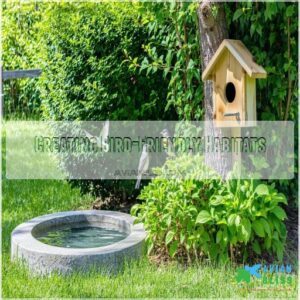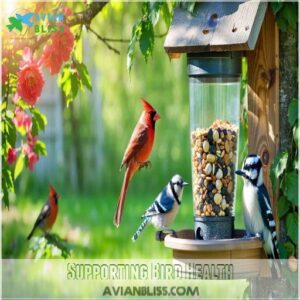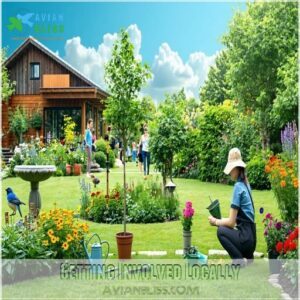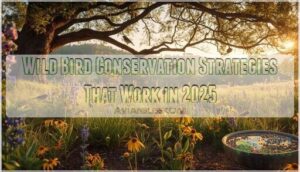This site is supported by our readers. We may earn a commission, at no cost to you, if you purchase through links.
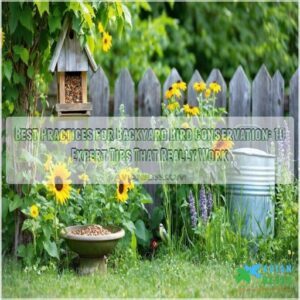
Add bird feeders, birdbaths, and nesting boxes to attract feathered friends. Keep these clean to keep bird diseases at bay; a little bleach solution works wonders.
Protect birds from predators by securing trash, using deterrents, and keeping cats indoors.
Table Of Contents
- Key Takeaways
- Creating Bird Friendly Habitats
- Reducing Threats to Birds
- Preventing Window Collisions
- Controlling Predator Access
- Supporting Bird Health
- Conserving Bird Populations
- Sustainable Gardening Practices
- Bird Friendly Backyard Features
- Protecting Bird Nests
- Getting Involved Locally
- Frequently Asked Questions (FAQs)
- How can I improve my bird-friendly backyard?
- How do I restore habitat for birds at home?
- Why should you make your backyard more bird-friendly?
- How do I attract more backyard birds?
- How do you make a bird-friendly yard?
- How do you keep birds safe in your backyard?
- What is the best way of protecting the endangered bird?
- How do you build an outdoor bird sanctuary?
- How long to soak raisins for birds?
- What happens if you stop feeding birds?
- Conclusion
Key Takeaways
- Plant native species to provide food, shelter, and natural habitat while reducing water usage and maintenance.
- Keep feeders, birdbaths, and nesting boxes clean and well-maintained to support bird health and prevent disease.
- Protect birds by marking windows to prevent collisions, keeping cats indoors, and using deterrents to ward off predators.
- Participate in community science projects like bird counts to help track bird populations and support conservation efforts.
Creating Bird Friendly Habitats
Transform your yard into a personal paradise for local birds with native plants and natural food sources, and you’ll be amazed at how quickly they discover it.
By creating a layered landscape with trees, shrubs, and flowering plants, you’re not just making a garden; you’re building a five-star bird resort complete with dining, lodging, and entertainment.
Native Plant Species
Want to make your yard a bird paradise? Start with five key native plant species that local birds already know and love. You’ll slash your water bills and maintenance time since these climate-adapted plants are built for your area’s conditions.
Incorporating native plants is essential for creating a wildlife-friendly habitat.
Visit native plant nurseries to pick species that pull double duty – feeding birds while beautifying your space. Think of it as birdscaping with benefits!
Layered Landscapes
Now that you’ve got your native plants picked out, let’s arrange them like nature does – in layers.
Think of your yard as a bird-friendly high-rise: tall trees create canopy cover up top, understory shrubs fill the middle floors, and groundcover plants carpet the ground level.
This vertical structure mimics natural habitats, giving birds multiple "apartments" to nest, feed, and hide in your backyard bird habitat.
Wildflower Meadows
Transforming your lawn into a wildflower meadow creates a natural buffet for local birds. Your backyard bird habitat comes alive when you swap traditional grass for native plants that attract insects and produce seeds.
Incorporating bird houses can further enhance the biodiversity of your meadow. Here’s what makes meadow design work:
- Choose native plants that bloom in rotation throughout seasons
- Leave dried flower heads standing for winter food
- Mow just once yearly in early spring
- Mix grasses with flowering plants for diverse structure
- Skip fertilizers to maintain natural growing conditions
Reducing Threats to Birds
Every day, backyard birds face threats that can turn their sanctuary into a danger zone.
Before diving into threat assessment, let’s tackle the biggest challenges head-on.
Your outdoor cats might be cute, but they’re natural hunters – keeping them indoors or in a "catio" dramatically reduces bird fatalities.
Bird safety nets around vulnerable areas create protective zones where your feathered friends can feed without fear.
In the area of hazard removal, start by securing trash containers that attract predators like raccoons and foxes.
Wildlife preservation means going pesticide-free in your yard – these chemicals don’t just kill insects, they harm birds too.
Consider setting up deterrents like reflective tape or wind chimes to keep larger predators at bay.
Bird conservation tips often overlook the basics, but smart positioning of feeders away from dense brush can prevent ambush attacks.
Cat predation accounts for billions of bird deaths annually, so this simple change makes a huge difference, and keeping them indoors is a key part of wildlife preservation and bird safety.
Preventing Window Collisions
You’ve probably noticed birds flying into your windows, and it’s not just because they’re admiring their reflections – window strikes actually kill millions of birds each year in North America alone.
Don’t worry though, you’ll learn some simple but effective ways to make your windows bird-safe without turning your home into a fortress.
Window Screens
Window screens are your first line of defense against bird collisions, acting like a safety net for our feathered friends.
Here’s what makes screens so effective:
They are often made with bird window materials that provide added protection.
- They break up reflective surfaces that confuse birds.
- The mesh provides a gentle bounce if birds do hit.
They’re already part of most homes, making implementation easy. You can install them seasonally during peak migration.
Additionally, they double as insect barriers while protecting birds.
Decals and Stickers
Many homeowners find that window decals and bird stickers are their first line of defense in protecting birds from deadly collisions.
You’ll want to space these glass markers no more than 2 inches apart vertically or 4 inches horizontally – birds will try to fly through larger gaps.
For effective application, consider the size and pattern of the decals, choosing transparent coatings or decorative decals that complement your home’s style while creating a bird-friendly habitat that saves lives. Choose transparent coatings or decorative decals that complement your home’s style and create a bird-friendly habitat.
Consider the size and pattern of the decals, such as transparent coatings or decorative decals that complement your home’s style, and for effective window decals application.
UV Reflective Films
While decals work well, UV reflective films take bird safety to the next level. These nearly invisible window coatings create patterns birds can see but you barely notice. For effective collision prevention, consider using bird safety solutions that reduce window collisions.
- Install films on exterior surfaces to break up reflections
- Choose patterns that cover 20-40% of the glass
- Position them where direct sunlight hits
Plus, these films help with energy costs by reducing heat – a win for both birds and your wallet, and provide bird safety and collision prevention with window collisions.
Controlling Predator Access
You’ll be amazed at how a few simple changes to your backyard can protect your feathered friends from neighborhood predators like cats and raccoons.
While you can’t control every threat to backyard birds, you can create safer spaces by setting up strategic barriers and escape routes that’ll give birds a fighting chance when danger strikes.
Securing Trash Containers
Three simple container security measures can transform your birdfriendly backyard into a safer haven. Start by investing in heavy-duty trash can lids with tight-fitting clasps – they’re your first line of defense in protecting backyard birds from opportunistic raiders.
For outdoor storage, consider wildlife-proof containers that lock securely. Using wildlife proof systems can provide an additional layer of protection for your backyard birds.
You’ll also want to rinse food containers before disposal, as lingering smells attract unwanted visitors to your bird conservation sanctuary.
Using Deterrents
Now that your trash is secure, let’s explore smart ways to keep predators at bay.
Visual deterrents and physical barriers work wonders in protecting your backyard birds.
For effective bird control, consider using bird deterrents that incorporate multiple sensory elements to scare away unwanted visitors.
Here’s what works best:
- Flash tape and predator eye balloons create movement that spooks unwanted visitors
- Bird spikes and slopes prevent landing in problem areas
- Sound devices playing distress calls send a clear "keep away" message
- Scent-based repellents with grape extract naturally discourage persistent predators
Escape Routes
While deterrents can discourage predators, your backyard birds need quick escape routes to stay safe.
Create protective foliage zones by planting dense shrubs and thorny bushes around feeding areas. Ground cover and strategically placed brush piles give small birds instant hiding spots when hawks swoop in.
Effective bird escape routes often rely on native plant species that provide the best cover. Think of it as building tiny bird bunkers – these natural sanctuaries are lifesavers for your feathered friends.
Supporting Bird Health
You’ll be amazed at how a few simple steps can keep your backyard birds healthy and thriving, just like having a wellness plan for your own family.
By regularly cleaning your bird feeders and birdbaths, watching for signs of illness, and providing nutritious food sources, you’re creating a safe haven that’ll help your feathered friends stay strong for generations to come.
Disinfecting Feeders
Keeping your bird feeders clean is your next line of defense, just as you’ve secured your yard against predators.
Make bird feeder maintenance a weekly habit – soak feeders in a solution of one part bleach to nine parts water, scrub off any mold or debris, and let them dry completely.
This hygiene practice prevents harmful bacteria and diseases from spreading among your backyard visitors.
Providing Food Sources
Cleaning feeders is great, but offering the right food keeps birds thriving. Stock up on black-oil sunflower seeds or millet for small birds, suet for winter, and nectar for hummingbirds.
Mix natural food sources like native plants with supplemental feeding.
To learn more about bird feeding basics, consider the types of food and feeder placement. Place bird feeders near cover, away from windows.
Diverse food sources guarantee happy birds and vibrant backyards.
Reporting Sick Birds
Noticing unusual behavior in backyard birds, like lethargy or ruffled feathers, could signal illness.
Reporting sick bird symptoms to local wildlife rehabilitation centers helps with Bird Disease Tracking and Avian Health Monitoring.
This contributes to broader bird conservation efforts, think of it as alerting the neighborhood watch—you’re protecting backyard birds and helping experts track bird mortality rates for conservation gains.
Conserving Bird Populations
You can help conserve bird populations by joining local groups and getting involved in community science projects like bird counts.
These activities support critical research as well as connect you with others who care about protecting birds, making conservation both meaningful and fun.
Joining Local Groups
Joining bird clubs or conservation organizations is a fun way to boost bird conservation efforts while connecting with others.
Community engagement through group meetings or volunteer work supports local outreach initiatives and builds lasting bonds.
Bird watching communities often share tips, host events, and inspire conservation initiatives.
These groups turn passion into action, making a real difference for feathered friends.
Participating in Bird Counts
Get involved in bird counts to track bird population data and support conservation tracking efforts.
Learn bird survey methods and counting techniques to contribute meaningful data.
Use free data analysis tools provided by bird conservation organizations for accuracy. It’s a simple way to boost backyard bird conservation while strengthening citizen science roles—and you can even do it from your own yard!
Community Science Projects
Think bird watching is just for kicks? With community science projects like NestWatch or eBird, you’re directly helping bird conservation.
These citizen science efforts turn your sightings into real data scientists use for species tracking and data analysis.
It’s easy, engaging, and impactful. A quick ten-minute watch could make you a conservation superhero!
You can also participate in community science projects to contribute to the conservation of bird populations.
Sustainable Gardening Practices
You can make your garden a bird haven by swapping harsh chemicals for natural practices like composting and mulching.
These small changes create healthier soil, support insect life, and turn your yard into a buffet for hungry birds—without adding to your water bill.
Shade Grown Coffee
Supporting bird conservation can be as simple as choosing shade-grown coffee. These sustainable beans are grown under a canopy of trees, preserving forest habitats and providing shelter for migratory birds.
It’s an eco-friendly choice that makes a big impact. Look for Fair Trade labels to promote sustainable living while enjoying your morning cup in a bird-friendly backyard.
Small choices matter!
Reducing Plastic Use
Switching to ecofriendly living is easier than you’d think.
Start small—trade single-use plastics for sustainable materials like cloth bags or stainless steel bottles.
Recycling practices help, but reducing use matters more.
Plastic pollution harms wildlife, so opt for biodegradable options when possible.
Every swap you make supports sustainable living and builds a brighter future for birds and the planet.
Mulching and Composting
Cutting plastic waste helps the planet, while nurturing your soil completes the picture.
Mulch types like arborist chips boost soil health and lock in moisture. Composting turns scraps into organic matter for better plant growth. Compost tea enriches native plants, tying into organic gardening for birds.
These eco-friendly practices aid carbon sequestration, making your yard a true bird-friendly habitat. By adopting bird conservation methods, you can further enhance the biodiversity of your backyard ecosystem.
Bird Friendly Backyard Features
You can make your yard a bird magnet by adding thoughtful features like feeders, birdbaths, and nesting boxes.
These small additions create essential resources birds need to thrive, turning your backyard into a safe and welcoming haven.
Bird Feeders
Bird feeders bring the joy of feathered visitors right to your backyard. Placement is key—keep them visible but safe from predators. Clean feeders regularly to maintain bird health.
Offer varying feeder types, like tube, platform, or suet feeders, to attract diverse species. Stock them with high-quality seeds and nuts as supplemental feeding, ensuring proper bird nutrition alongside natural food sources.
- Position feeders near shelter for safety.
- Clean weekly to prevent disease.
- Use varied feeders for different bird species.
- Choose native-friendly seeds.
- Keep predators away with smart placement.
Birdbaths
After setting up feeders, add a birdbath to complete your backyard haven.
Keep water fresh, clean weekly, and maintain a basin depth of 1-2 inches for safe bird bathing.
In winter, a heater prevents freezing.
Placement matters—choose shady, open spots for safety.
Birds need reliable water sources for drinking and bathing.
| Aspect | Recommendation | Why It Matters |
|---|---|---|
| Basin Depth | 1-2 inches | Prevents drowning, keeps birds safe |
| Cleaning Frequency | Once a week | Stops algae and bacteria growth |
| Heater Usage | Winter only | Keeps water accessible year-round |
Nesting Boxes
A birdbath’s charm pairs beautifully with a well-placed nesting box.
Opt for sturdy nest boxes suited to bird species common in your area.
Install boxes in quiet spots, away from predators.
Add soft nesting materials while maintaining proper box maintenance each season.
Smart nest placement makes your yard a bird-friendly habitat and helps backyard bird conservation feel more rewarding than ever.
Protecting Bird Nests
Protecting bird nests means giving birds a safe place to raise their young without interference from predators or human activity.
You can support nesting birds by safeguarding their habitats and taking simple steps to keep their homes secure.
Nesting Habitat Creation
If you’ve set up feeders and birdbaths, it’s time to think about nesting sites.
Proper bird habitat creation means providing safe spots like birdhouses or nest boxes.
Use eco-friendly materials and align your nest box design with the needs of local birds.
Plant trees and shrubs or embrace habitat restoration by letting wild areas thrive.
Each bird shelter you create adds a significant layer of protection, giving birds a cozy place to call home.
Predator Proofing
Protecting backyard birds doesn’t stop at creating nesting spots—it’s about keeping predators out too. Predators love an easy meal, but simple steps can boost bird safety and create a secure, bird-friendly habitat. To further enhance security, consider using predator proofing methods like burying hardware cloth around the coop to deter digging predators.
- Cat Deterrents: Keep cats indoors or use “catios” to stop sneaky prowlers.
- Predator Guards: Install baffles on nest poles to block climbing threats.
- Fence Security: Use tight fencing or buried mesh to deter diggers.
- Wildlife Protection: Store trash securely to avoid attracting scavengers.
Getting Involved Locally
You can make a big impact on backyard bird conservation by connecting with local groups or projects.
Whether it’s volunteering, supporting nature centers, or joining citizen science efforts, your actions help protect bird populations while building a stronger community.
Volunteering for Conservation
Joining conservation efforts as a bird conservation volunteer is a hands-on way to make a difference. Help wildlife rescues, support bird sanctuaries, or assist eco volunteering projects in your area.
From monitoring nests to organizing community outreach events, bird conservation collaborations build stronger bird conservation networks.
By participating in citizen science projects, individuals can contribute to the preservation of bird populations and ecosystems.
Get involved locally, connect with bird conservation partnerships, and inspire others to join the mission.
Supporting Nature Centers
Supporting nature centers is a simple way to protect birds while strengthening conservation initiatives. Your donations or memberships fund bird conservation programs and environmental education.
Many centers host community events and educational programs to boost conservation awareness. Volunteering there connects you with experts, while your time helps bird conservation organizations grow.
It’s like giving back to the birds that brighten your backyard!
Participating in Citizen Science
Engage with citizen science projects and make a real difference! Contribute to bird conservation by participating in annual bird counts or birdwatching communities.
Share observations through online bird databases, helping ornithological research and bird population monitoring.
These projects, often led by bird conservation organizations, are like nature’s detective work—fun, simple, and critical for tracking changes. Every sighting counts!
Frequently Asked Questions (FAQs)
How can I improve my bird-friendly backyard?
Plant native species for food and shelter, and ditch pesticides. Keep your cat indoors.
Add birdbaths, feeders, and wildflower patches for variety.
Mark windows to prevent crashes, and leave some areas wild for nesting.
How do I restore habitat for birds at home?
Leave part of your yard wild and swap lawns for native plants.
Add shrubs or thickets for shelter.
Offer water with birdbaths, avoid chemicals, and make windows bird-safe to restore essential habitat.
Why should you make your backyard more bird-friendly?
Making your backyard bird-friendly helps preserve biodiversity, supports pollination, and curbs pesky insects.
Plus, birds bring life and music to your space.
It’s like creating a sanctuary that benefits them—and your little ecosystem.
How do I attract more backyard birds?
Plant native flowers and shrubs, hang feeders with diverse seeds, and add a birdbath for hydration.
Keep your space wild by leaving seed heads and brush piles, creating a cozy buffet birds can’t resist visiting.
How do you make a bird-friendly yard?
Create a bird-friendly yard by incorporating native plants, water sources, and shelter such as shrubs or trees.
Supplement their natural food sources with feeders and berry bushes, and offer treats.
Protect birds further by avoiding chemical use and keeping cats indoors.
How do you keep birds safe in your backyard?
Keep birds safe by marking windows to prevent collisions, keeping cats indoors, and providing hiding spots like shrubs or brush piles.
Skip pesticides, clean feeders often, and keep outdoor lights low to avoid confusing migratory birds.
What is the best way of protecting the endangered bird?
Imagine a world without their songs—prevent it by planting native plants, avoiding pesticides, and keeping pets indoors.
Mark windows to stop deadly collisions, and report sick or dead birds to help track and combat diseases.
How do you build an outdoor bird sanctuary?
Start by planting native shrubs, trees, and flowers to provide food and shelter.
Add fresh water sources and birdhouses for nesting.
Keep it natural—let parts grow wild, and avoid pesticides to protect their habitat.
How long to soak raisins for birds?
Soak raisins for birds in warm water for about 30 minutes to soften them.
This makes eating easier, especially for smaller birds.
Softened raisins also mimic natural fruit textures, which birds love nibbling on.
What happens if you stop feeding birds?
When you stop feeding birds, they’ll adapt by seeking natural food sources, like insects and berries.
However, during harsh winters or migration, they might struggle more.
Consistency helps birds’ survival and supports their routines.
Conclusion
Picture a chickadee thriving in a yard full of native plants, safe from predators, and well-fed through clean bird feeders you’ve maintained.
By following these best practices for backyard bird conservation, you’re not just beautifying your space—you’re helping local bird populations.
Small actions like planting wildflowers, preventing window collisions, or joining a bird count can make a big difference.
So, keep learning and taking these steps, and soon your backyard will become a haven for feathered visitors.

